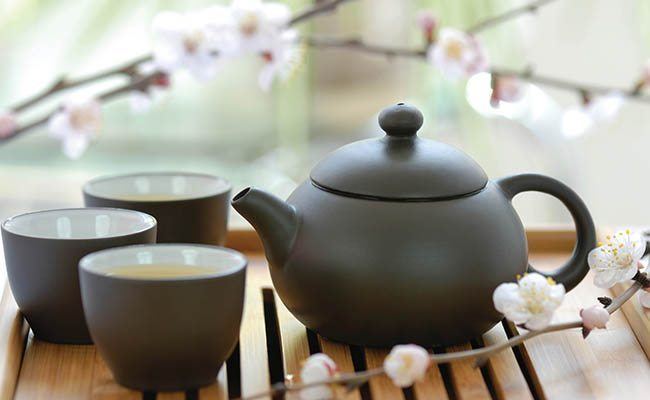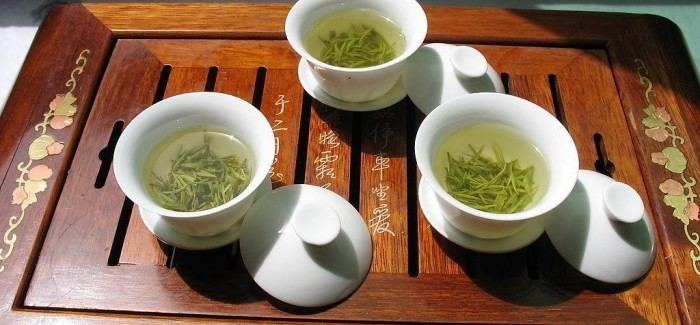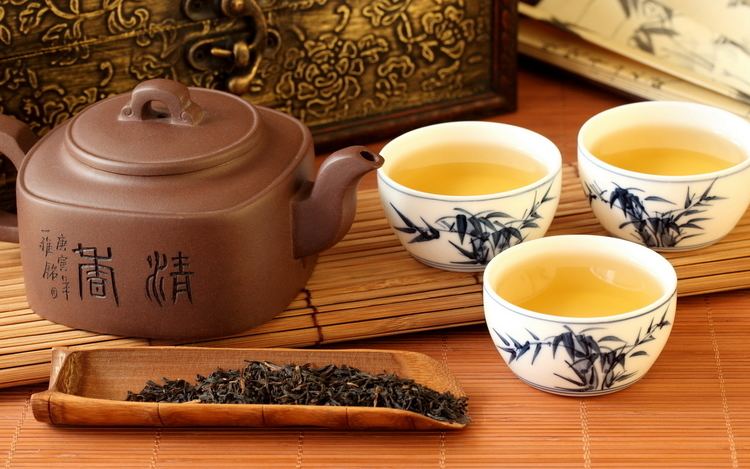 | ||
Similar Oolong, Pu‑erh tea, Black tea, Fermented tea, Flowering tea | ||
Chinese tea is a beverage made from the leaves of tea plants (Camellia sinensis) and boiled water. Tea leaves are processed using traditional Chinese methods. Chinese tea is consumed throughout the day, including during meals, as a substitute for plain water, for health, or for simple pleasure.
Contents
- How to make chinese tea
- History
- Song Dynasty
- Ming Dynasty
- Huqiu and Tianchi tea
- Jie tea
- Luan tea
- Songluo tea
- Longjing and Tianmu tea
- Customs and etiquette
- Utensils
- Chinese Tea Culture Research Institute
- Tea garden
- Tea house
- Ba Shu culture and Sichuan teahouses
- Wu Yue culture and Hangzhou teahouses
- Tianjin teahouses Shanghai Fuchaguan teahouses and Guangdong tearooms
- Beijing teahouse culture
- Shuchaguan
- Qingchaguan
- Qichaguan
- Yechaguan
- Dachaguan
- Erhunpu
- Symbolism and significance
- Production
- Trade
- Varieties
- References

How to make chinese tea
History

The practice of drinking tea has a long history in China, having originated there. Although tea originated in China, during the Tang Dynasty, Chinese tea generally represents tea leaves which have been processed using methods inherited from ancient China. According to popular legend, tea was discovered by Chinese Emperor Shen Nong in 2737 BCE when a leaf from a nearby shrub fell into water the emperor was boiling. Tea is deeply woven into the history and culture of China. The beverage is considered one of the seven necessities of Chinese life, along with firewood, rice, oil, salt, soy sauce and vinegar. Around 771 BC – 476 BC the Chinese tea is used for medicinal purposes.This period also known as the “Spring and Autumn Period”, it is where Chinese people first enjoyed the juice extracted from the tea leaves that they chewed.

Chinese tea can be classified into five distinctive categories: white, green, oolong, black and post-fermented. Others add categories for scented and compressed teas. All of these come from varieties of the Camellia sinensis plant. Most Chinese teas are consumed in China and are not exported, except to Chinese-speaking communities in other countries. Green tea is the most popular type of tea consumed in China.

Within these main categories of tea are vast varieties of individual beverages. Some researchers have counted more than 700 of these beverages. Others put the number at more than 1,000. Some of the variations are due to different strains of the Camillia plant. The popular Tieguanyin, for example, is traced back to a single plant discovered in Anxi in Fujian province. Other teas draw some of their characteristics from local growing conditions. However, the largest factor in the wide variations comes from differences in tea processing after the tea leaves are harvested. White and green teas are heat-treated (simplified Chinese: 杀青; traditional Chinese: 殺青) soon after picking to prevent oxidization, often called fermentation, caused by natural enzymes in the leaves. Oolong teas are partially oxidized. Black teas are fully oxidized. Other differences come from variations in the processing steps.
Song Dynasty
Tea was an important crop during the Song Dynasty. Tea farms covered 242 counties during this time. This included expensive tribute tea, which was tea from Zhejiang and Fujian provinces that was exported to Southeast Asian and Arab countries.
In the Song Dynasty, tea started to be pressed into tea cakes. Some were embossed with patterns of the Chinese dragon and the Phoenix, and were called exotic names including:
Large Dragon tea cake, Small Dragon tea cake, Surpassing Snow Dragon ball cake, Fine Silver Sprout, Cloud Leaf, Gold Money, Jade Flower, Inch of Gold, Longevity Sprout, Eternal Spring Jade Leaf, Dragon in the Clouds, Longevity Dragon Sprout, Dragon Phoenix and Flower, and Eternal Spring Silver Sprout.
Ming Dynasty
The Ming Dynasty scholar Wen Zhenheng's encyclopedic book Zhang Wu Zhi (simplified Chinese: 长物志; traditional Chinese: 長物志; Treatise on Superfluous Things), volume 12, contains the following descriptions of several famous Ming Dynasty teas:
Huqiu and Tianchi tea
During this time, Huqiu tea (Chinese: 虎丘茶; lit. "Tiger Hill tea"), not to be confused with the black tea of the same name from the Nilgiris District in what is now Tamil Nadu, India) was purportedly developed as the finest tea in the world; however, the production quantity was rather small, and the production is regulated by the Chinese government. Some, however, consider its taste to be second to Tianchi tea (Chinese: 天池茶; lit. "Heaven Pool").
Jie tea
Jie tea Chinese: 岕茶 from Changxing County in Zhejiang Province is regarded highly by connoisseurs, although it is rather expensive.
NB: Jie is the short name for Luo Jie (simplified Chinese: 罗岕; traditional Chinese: 羅岕). Luo Jie is the name of a mountain bordering Zhejiang and Jing Qi where, during the Ming dynasty, jie meant boundary. Chang Xin lay to the south of Luo Jie mountain while Jing Qi lay to the north of it. Chang Xin still retains its name today.
Luo Jie tea from Gu Chu Mountain in Changxing County in Zhejiang Province was also known as Gu Chu Violet Shoot. Gu Zhu Violet Shoot had been an imperial tribute tea since the Tang dynasty for nearly nine hundred years until the middle of the Qin dynasty. Gu Zhu Violet Shoot was revived again in the 1970s as a top grade tea in China.
NB. Jin Qi is now called Yi Xin township. Jin Qi tea was also known as Yang Xian tea. Ruo leaves are leaves from Indocalamus tessellatus bamboo. The leaf is about 45 cm long.
Lu'an tea
Lu'an tea (Chinese: 六安茶),which is also called Lu'an Melon Seed tea, is used for Chinese medicine. It cannot release its aroma and has a bitter taste if it is not baked right. The inherent quality of this tea is considered quite good. This type of tea is especially suitable for people who are suffering from gastric problems.
Lu'an tea is still produced in China, Anhui Province, China. The Lu'an tea from the Bat Cave of Jinzhai County is considered of superior quality, as thousand of bats in the cave can provide an ideal fertilizer for the tea plants.
Songluo tea
Songluo tea is manufactured at Songluo Mountain located north of Xiuning County in Anhui Province, China. The tea plantations are scattered at an elevation of six to seven hundred meters on the mountain.
There is no real Songluo tea grown outside an area of a dozen mu (one mu = 667 square meters) and only few families possess the refined full to prepare Songluo tea. The tea hand-baked recently by mountain monks is even better.
Genuine Songluo tea is produced at the foot of the Dongshan (Cave Hill) and on top of the Tianchi (Chinese: 天池; lit. "Heaven Pool"), highly treasured by people in Xin'an County. It is also a favorite for the people of Nandu and Quzong counties, due to its ease in brewing and intense aroma.
Longjing and Tianmu tea
Longjing tea and Tianmu tea may match Heaven Pool tea due to the weather in their growing regions. Because the cold season comes earlier to the mountains, there is abundant snow in the winter, hence the tea plants germinate later. [Wen Zhenheng]
Longjing tea is manufactured in the West Lake district of Hangzhou, China. The Longjing, literally "Dragon Well", is located at Fenghuang Mountain. Tianmu Mountain is located at Lin'an County in the north west of Zhejiang Province. There are two 1500-meter peaks, each with a pond on top filled with crystal clear water looking like an eye, hence the name Tianmu (Chinese: 天目, lit. "heaven eye").
Customs and etiquette
Throughout China, in restaurants, it is common for customers to clean their bowls and utensils at the table by rinsing them with tea from the pot. Tea may be poured over utensils into one of their bowls, or a larger bowl is may be provided as a waste receptacle for tea used to rinse bowls.
Utensils
Teapots, teacups, tea spoons, tea strainers, draining trays, tea caddies,...
Chinese Tea Culture Research Institute
Chinese Tea Culture Research Institute is directly under the central authority China Federation China ADPL approved the establishment of subordinate units, the Association issued document No. 20 [2016], by the Central Propaganda Department guidance.
China tea culture research institute office, compiled in the SASAC of the State Council, the Central Organization Department, the Central Propaganda Department, the National Federation of trade unions, People's Republic of China Ministry of education, Ministry of culture, People's Republic of China China Federation of literary and art circles, the Ministry of civil affairs and other party, government and military departments and the leadership of the care and concern, from dozens of universities and national research institutions, organizations, tea experts, university professors, Ph.D., researchers, scholars and industrialists as members of the legitimacy and authority of the media, research Ancient Chinese Literature Search non-profit organization.
China Tea Culture Research Institute official website is: www.chinateayjy.org
Tea garden
A tea house which features a Chinese garden or a domestic Chinese garden in which people enjoy their tea.
Tea house
Chinese tea house refer to the public place where people gathered to drink tea and generally developed into public entertainment place as well. Chinese tea house has a long history. It first took shape during the Tang dynasty Kaiyuan era (713–714) and became popular during the Song Dynasty. From the Ming and Qing dynasties, tea house culture was integrated with regional culture.
Ba-Shu culture and Sichuan teahouses
Sichuan teahouses have various sizes. The large ones have hundreds of seats, while the small ones, only a few. They also have excellent services. Traditional Sichuan teahouses use red copper teapots, tin saucers, teacups with covers made of Jingdezhen porcelain, tuocha- a bowl-shaped compressed tea leaves- and tearoom keepers expert at all manner of work. What's more, Sichuan teahouses have social functions. They play an important role in spreading the state affairs information. People can chat with each other there. They also serve as unofficial courts.
Wu-Yue culture and Hangzhou teahouses
Wu-Yue area is famous for tea producing and green tea produced in Zhejiang province play a decisive role.In Hangzhou, most tearooms are elegant, simple and unsophisticated. They emphasize making tea with good-quality water and tasting tea in an excellent environment in order to achieve the true meaning of tea art.
Tianjin teahouses, Shanghai Fuchaguan teahouses and Guangdong tearooms
Most of the Tianjin teahouses meet the needs of business people from different parts of China. People of various trades drink tea while eating refreshments and appreciating performances which include singing of opera arias, storytelling and dagu (a versified story sung to the accompaniment of a small drum and other instruments).
In the past, Shanghai teahouses are regarded as learned and refined places in Shanghai.Shanghai people called teahouses fuchaguan to express their longing for leisure.The most typical teahouse with local features was situated in the old Chenghuangmiao area.
The old Guangdong tearooms were inexpensive. Regular customers would be served with a cup of tea, and two steamed buns stuffed with diced grilled pork, steamed dumplings with the dough gathered at the top, or dumplings with shrimp stuffing. However, teahouses become different now. Nowadays, customers are provided with a pot of strong tea as soon as they arrive, and have many choices from a great variety of refreshments on the food cart.
Beijing teahouse culture
Beijing teahouses show most of the advantages of other local teahouses. They are known for their various functions, and rich and profound cultural aims.
There are many kinds of Beijing teahouses, which include Shuchaguan, Qingchaguan, Qichaguan, Yechaguan, Dachaguan, and Erhunpu.
Shuchaguan
Teahouse culture made a special contribution to the development of the novel, and shuchaguan was the best evidence to explain. At shuchaguan, tea is only acted as a medium and supplement because people came mainly to listen to storytelling. Storytelling was performed two times a day and a long story would last two or three months. Famous shuchaguan were exquisitely furnished with cane or wooden tables and chairs, and decorated with works of calligraphy and painting in order to build an atmosphere for storytelling. The purpose of drinking tea in shuchaguan is increasing their historical knowledge, killing time and amusing themselves. So shuchaguan were best suited to old people.
Qingchaguan
Qingchaguan provides places for people from all walks of life to entertain themselves elegantly. In the past, most of the Qingchaguan were simply furnished with square tables and wooden chairs. Teacups with covers were used to serve tea. However, tea was served without refreshment in Qingchaguan.
Qichaguan
Qichaguan provides places for customers to play chess. Qichaguan were simply furnished with timber or lumps of wood painted with chess boards, which were partly buried in the ground, or chessboards with benches on both sides. When people played chess while drinking tea, they will feel that the chessboards was like a battlefield of life. Usually they would temporarily forget about their sufferings, and that's why tea was also called wangyoujun (Mr.Worry-free).
Yechaguan
People went to Yechaguan to appreciate beautiful gardens. People of Beijing in old times were keen on enjoying beautiful scenes in different seasons.So yechaguan were mostly built in those places with beautiful gardens and nice views.
Dachaguan
Dachaguan provided tea, food and excellent services to people in various trades such as business men and scholars. It became popular because of its multiple functions and good services.
In terms of service, it includes Hongluguan, Wowoguan and Banhuguan.
Hongluguan
Hongluguan were installed with red stoves which baked Manchurian and chinese pastries. They served all kinds of pastries, which were smaller and more exquisite than those made by pastry shops. Customers could drink tea while sampling these pastries.
Wowoguan
Wowoguan served various refreshment, including aiwowo, steamed sponge cakes, paicha, pengao and sesame seed cakes.
Banhuguan
Characterized by a large copper pot, banhuguan suited both refined and popular taste.
Erhunpu
Erhunpu served tea without refreshments, but provided dining and wining facilities. Ir supplied customers food cooked from a raw materials provided by itself or brought by customers.
Symbolism and significance
The China famous tea (Chinese: 中國名茶) or The Ten Great Chinese Teas (Chinese: 中國十大名茶) are the ten most notable Chinese teas. Below is a list of ten popular teas of China.
Production
The highest grades of white tea, yellow tea, and green tea are made from tender tea shoots picked early spring. These young tea shoots may consist of a single terminal bud, a bud with an adjacent leaf or a bud with two adjacent slightly unfurled leaves. It is generally required that the leaves are equal in length or shorter than the buds.
The more-oxidized tea—such as red or oolong tea—are made from more mature leaves. The Anxi Tieguanyin, for example, is made from one bud with two to four leaves.
Not all high grade green tea is made from tender tea shoots. The highly regarded green tea Lu An Gua Pian is made from more matured leaves.
Traditionally these tender tea shoots are picked before 5 April, or Qingming Festival. The standard practice is to start picking when 5% of the garden is ready, or when the tea buds reach certain size. In some tea gardens, tea shoots are picked daily, or every 2 days.
Trade
The increase in export of green tea from China has not been commensurate with production. During 2010, China exported 234 M kg of green tea as against 163 M kg in 2001. Interestingly, its share of export in the global market has been found to fall from 87% to 78% between 2003 and 2007. However, in 2010, China contributed 79% of the total green tea exported worldwide .
Varieties
Spelling of varieties often reflects English usage, and historical or southern-Chinese pronunciation rather than official modern pinyin, for example; Bohea (武夷茶 wǔyí chá), Congou (工夫 gōngfu), Hyson (熙春茶), Souchong (拉普山小種 lāpǔshān xiǎozhǒng), Chunmee (珍眉 zhēnméi), Sowmee (秀眉 xiùméi), Pekoe (白毫 báiháo), Keemun (祁門紅茶 qímén hóngchá).
